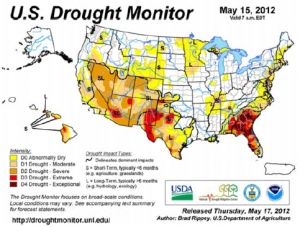World Markets

Last year is the perfect example. Lower costs and the continuing recovery of US beef exports in 2010 had many producers thinking expansion. But dry conditions beginning in late summer 2010 and then one of the most severe drought and heat wave combinations ever hit the major cowcalf areas in the Southwest. For cow-calf operations from Kansas south and west, what the economics of selling calves said did not matter. Survival became the key operational objective. But last year’s huge liquidation of beef cows set the stage for a great deal of interest in expansion — as soon as the pasture is available.
Conditions have improved steadily since last fall in the southwest. As can be seen in the 15 May US Drought Monitor map below, only a few areas are still seeing “Exceptional” drought conditions. The western two-thirds of Texas are still dry but are not in nearly as bad of shape as they were last year. Most of Oklahoma is now out of drought conditions and that improvement has driven what many expect will be a very good wheat crop. Dry conditions in the Southeast remain a concern primarily because of their duration. The Southeast dryness began before the drought in Texas and Oklahoma but has not been nearly as intense.

Only 22.5 per cent of the pasture lands in the Southern Plains (Texas and Oklahoma) were rated as poor or very poor in last week’s USDA Crop Progress report. That percentage of anything in poor or very poor condition probably sounds like an unmitigated disaster in to most readers. But as you can see from the chart at right, that percentage is about normal for this part of the country — and FAR BETTER than one year ago when the growing season began with over 60 per cent of acres in poor or very poor condition and ended with over 90 per cent in those dire straits.

Nationally, 19 per cent of acres were rated as in poor or very poor condition last week. That compares to 17 per cent the week before and 22 per cent last year. 51 per cent of the nation’s pasture acres were rated as in good or excellent condition last week, down 3 per cent from the week before and 3 per cent lower than one year ago.
The Livestock Marketing Information Center in Denver maintains an interesting set of calculations that we think measure the impacts of range and pasture conditions on the US beef sector quite well. The idea is simple: If drought strikes areas where there aren't as many cows, it will have far less impact. During early May 2011, over one-fourth of the beef cows in the US resided in states that had 40 per cent or more of their acres rated as poor or very poor. Just over 60 per cent were in states with 40 per cent or more of their acres rated good or excellent. After Texas dropped out of the poor/very poor group two weeks ago, only about 5 per cent of the US beef herd is now located in states with poor or very poor pasture conditions. Nearly 60 per cent of our beef cows are in states with 40 per cent or more of their pastures acres rated as good or excellent.
























